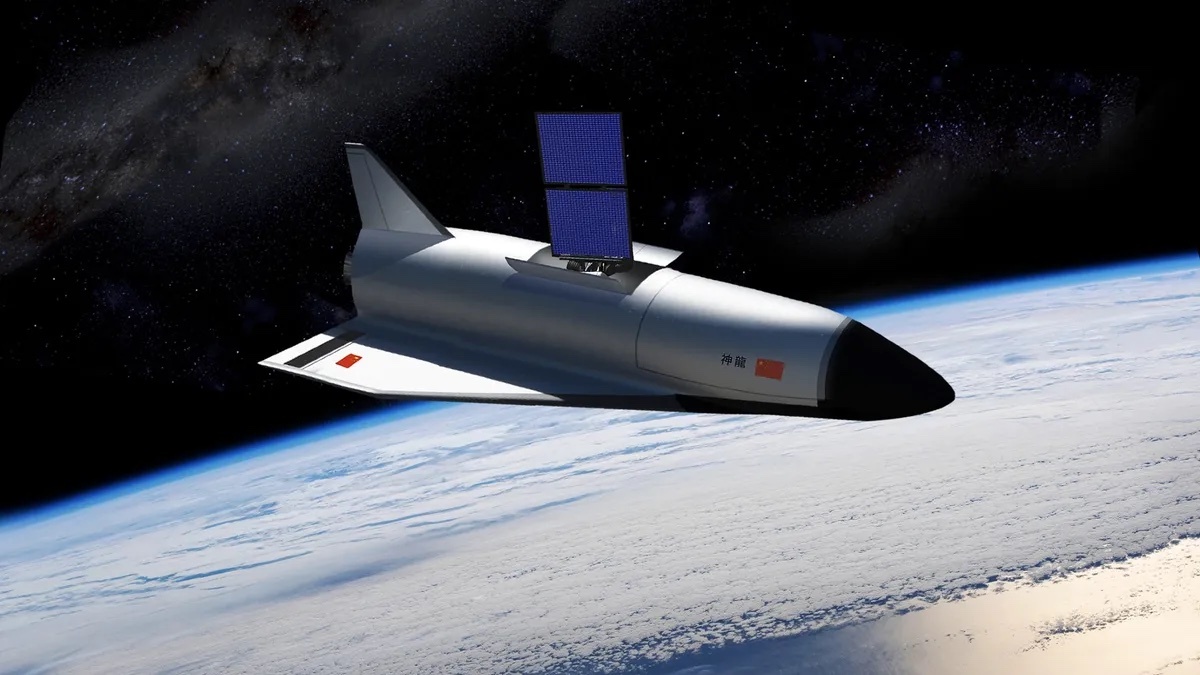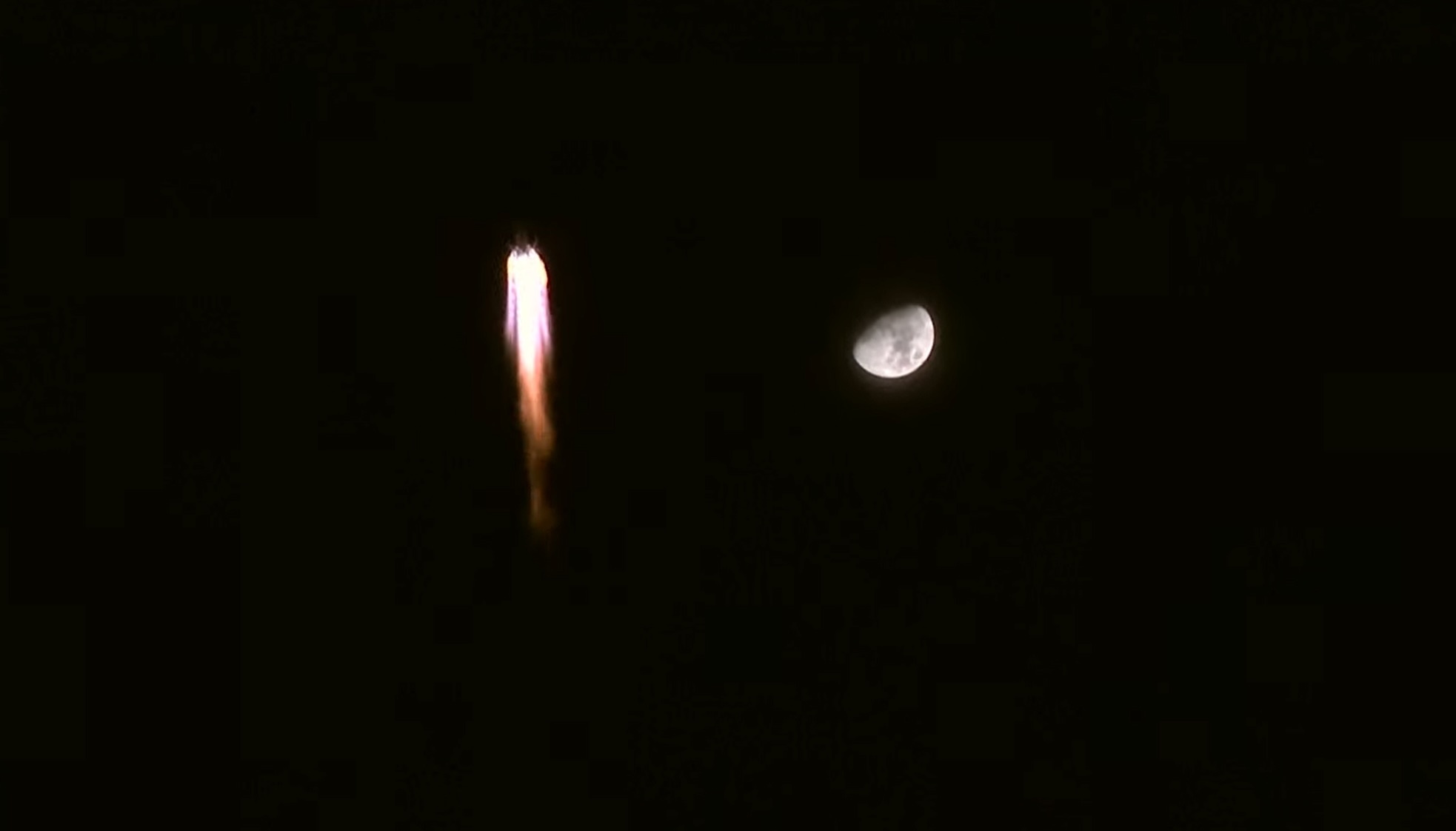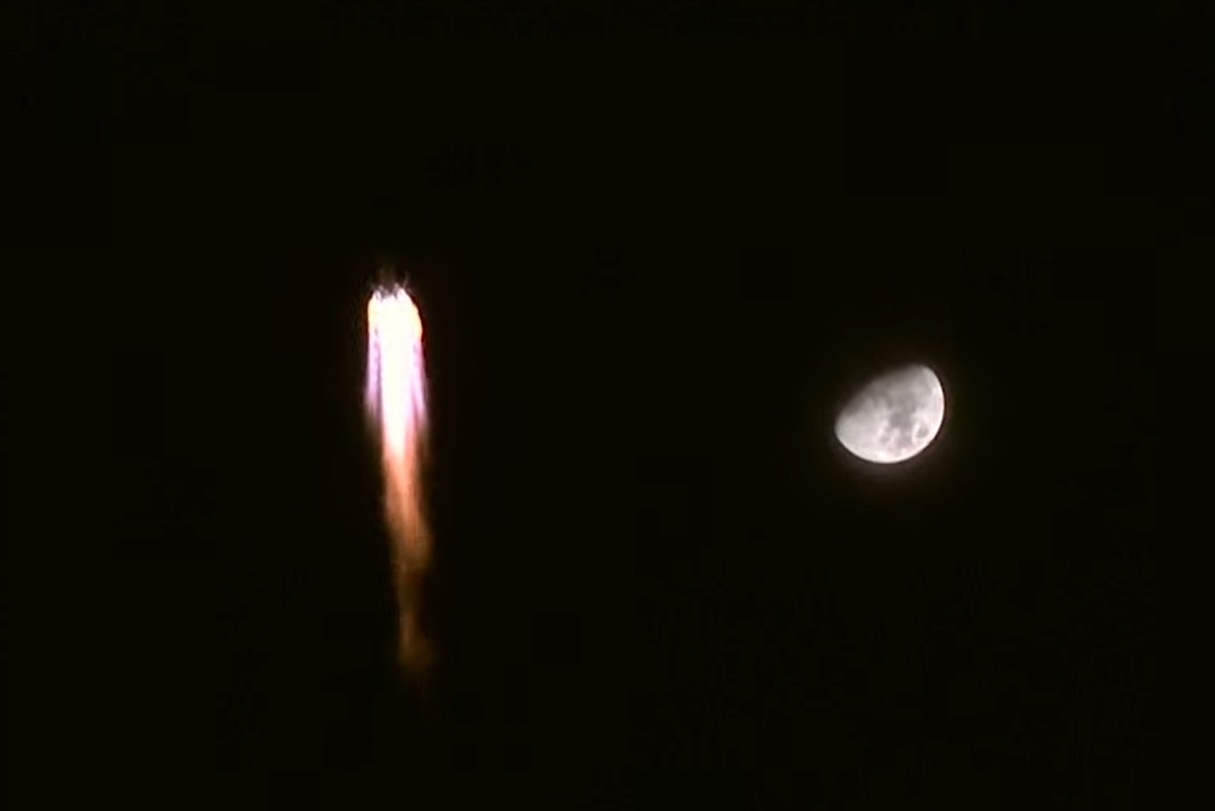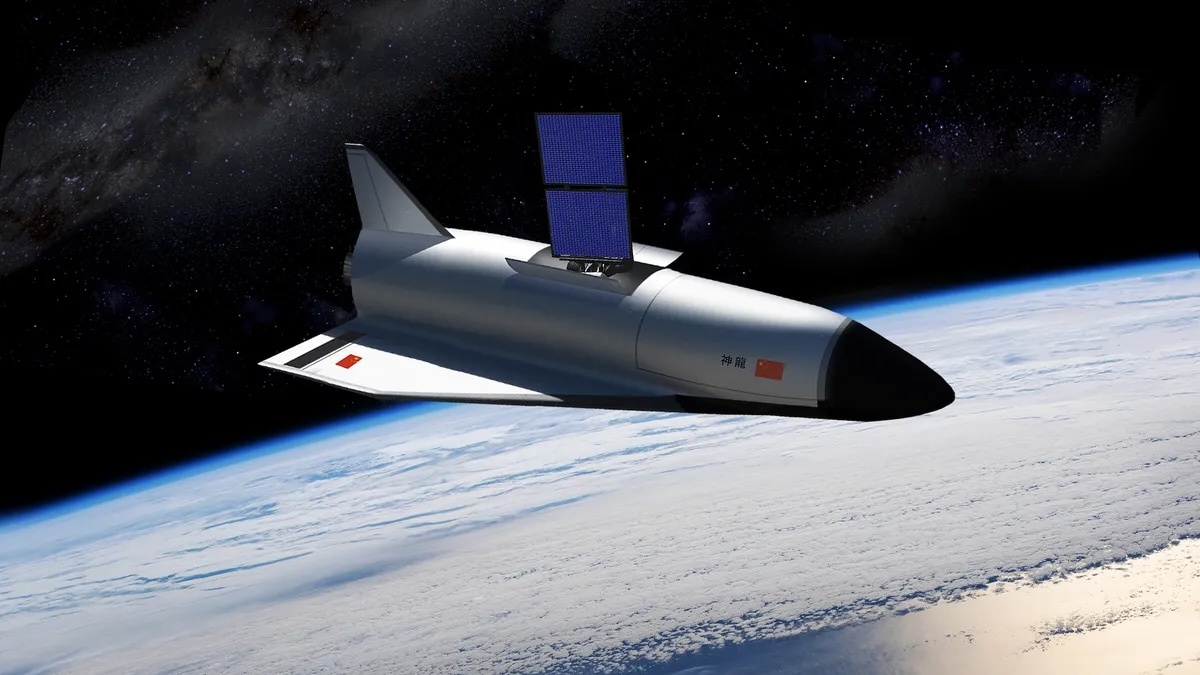20.12.2023
Some of the objects appear to be transmitting signals.

A notional rendering of China's reusable Shenlong space plane. (Image credit: Erik Simonsen/Getty Images)
China's reusable space plane just got a little more mysterious.
Just four days after being launched on its third mission, China's Shenlong("Divine Dragon") robotic space plane seems to have placed six objects into Earth orbit. Amateur spacecraft trackers around the world have been following the objects closely for days and have recorded emissions coming from some of them.
The six mystery objects have been designated OBJECT A, B, C, D, E and F. According to satellite tracker and amateur astronomer Scott Tilley, OBJECT A appears to be emitting signals reminiscent of those emitted by objects that China's space plane has released on previous missions.
"OBJECT A's or nearby emission is reminiscent of earlier Chinese space plane 'wingman' emissions in the sense the signal is modulated with a limited amount of data," Tilley told Space.com via email. "There is speculation that the emission from OBJECT A may be from an object close to it, but this is speculation not based on any evidence I'm aware of." Tilley has referred to the objects as "mysterious wingmen" on X (formerly Twitter).
OBJECT D and E, meanwhile, appear to be emitting idle "placeholder" signals with no data accompanying them. "It should be noted that unlike emissions early in the Chinese space plane missions 1 and 2, these emissions are very intermittent and do not stay on long," Tilley says. "It's taken days of observations tracking pass after pass with dish antennas to come up with this data."
Tilley and other satellite trackers have analyzed the signals and are confident that the emissions are coming either from the objects or from close proximity to them. This conclusion is based on observing them along their expected paths in the sky, the fact that no other known objects were in the beam of the trackers' antennas when the data was collected, and the fact that the particular modulation of these signals is "unique and has only been seen from previous Chinese space plane missions using [a frequency of] 2280MHz," Tilley says.
"In summary, this iteration of the Chinese space plane mission launched into a similar orbit as the last two but operationally it is exhibiting different radio behavior than before. The additional observations of the emissions from OBJECT D and E is new, but could also have been missed on earlier missions if they too were intermittent," Tilley added. "Something we should watch for is close encounters between OBJECT A and OBJECTs D and E. D and E are in fairly elliptical orbits while A is in a near circular orbit. In the next couple of days there will be close approaches between these objects at perigee."
Perigee is the point in a satellite's elliptical orbit when it's closest to Earth.
China's space plane has exhibited similar behaviors in the past. On its two previous missions — which launched in September 2020 and August 2022, respectively — the spacecraft was seen releasing a small unknown object into orbit. It was speculated that the objects could be service modules, test articles for practicing placing payloads into orbit, or perhaps even small satellites used to monitor the space plane, SpaceNews wrote in November 2022.
The United States also operates a reusable robotic space plane, the Boeing-built X-37B. Similar to China's Shenlong space plane, little is known about the exact operations or capabilities of the X-37B. The U.S. Space Force is currently set to launch the spacecraft atop a SpaceX Falcon Heavy rocket on Dec. 28 after several delays.
And the timing of the two reusable space plane launches isn't a coincidence. "These are two of the most watched objects on orbit while they're on orbit. It's probably no coincidence that they're trying to match us in timing and sequence of this," General Chance Saltzman, U.S. Space Force's Chief of Space Operations, said at a conference earlier this month.
Quelle: SC
----
Update: 2.02.2024
.
China’s secretive spaceplane raises its orbit, but yet to deploy satellites

A Long March 2F carrying Shenzhou-13 rising against the backdrop of the moon on Oct. 15, 2021. Credit: CCTV/framegrab
HELSINKI — China’s experimental reusable spacecraft recently performed maneuvers to raise its orbit but is apparently yet to release objects as it did during previous flights.
A Long March 2F rocket lifted off from the Jiuquan Satellite Launch Center in the Gobi Desert Dec. 14, beginning the third flight of what is considered to be a Chinese spaceplane. Though little is known about the project, it is widely thought the spacecraft is analogous to the U.S. Air Force’s X-37B.
The spacecraft entered an initial 333 by 348-kilometer-altitude orbit inclined by 50 degrees. U.S. Space Force space domain awareness data shows the spacecraft made a burn around Jan. 20 to raise its apogee, or farthest point from Earth, to 597 km.
A week later, the orbit was circularized into a 602 by 609-km orbit. This activity mirrors the spacecraft’s second mission, which raised itself from a similar initial orbit into a near-circular 597 by 608-km orbit after nearly three months in space.
China has not provided any details of the spacecraft nor updated on the mission, beyond the terse state media text published on the day of launch.
The spacecraft is seen as China’s attempt to develop similar capabilities to the X-37B.
“Based on what little information we have, I think the Shenlong [Chinese spaceplane] and the X-37B are likely doing many of the same missions,” Brian Weeden, Director of Program Planning at the Secure World Foundation, told SpaceNews in December. “That is, primarily being used for experimenting and testing new technologies, sensors, and perhaps even operational practices.
No satellites deployed — yet
Contrary to previous reports, there is no evidence as yet of the spaceplane releasing objects into orbit. Deployment of a subsatellite into orbit could follow the recent maneuvers, earlier experimental reusable spacecraft mission activities suggest.
The previous two missions saw the release of subsatellites that briefly transmitted signals. The second flight released its subsatellite after reaching its higher orbit.
The Chinese spaceplane was reported by some media to have released six satellites into orbit. Those reports were based on amateur spacecraft trackers suggesting that one of the objects other than the spaceplane were transmitting signals.
Six objects associated with the launch were cataloged in orbit. Five other objects were the Long March 2F upper stage and likely four pieces of debris typically associated with Long March 2F launches.
One of the spacecraft trackers later provided an update suggesting that a minor timing issue had led the trackers to mistake signals sent by a group of Chinese Yaogan reconnaissance satellites as being emitted by a piece of debris associated with the spaceplane.
Three of the four pieces of debris reentered the atmosphere earlier in January, according to U.S. Space Force tracking data. The final piece is expected to reenter and burn up in the coming days. The upper stage is predicted to reenter in March, with a large window of uncertainty.
Spaceplane mysteries
The spaceplane has been in orbit for 48 days during its third mission. Its first mission lasted just two days before landing at Lop Nur air base. The second mission—apparently demonstrating reusability—saw it orbit for 276 days, landing on May 8, 2023.
The gap between the spacecraft’s first and second missions—launching in 2020 and 2022 respectively—was one year and 11 months. The third mission saw a seven-month turnaround.
China has revealed no details of its experimental reusable spacecraft project. No images of any of the launches have been published. The spacecraft is launched vertically on a Long March 2F, a rocket used to launch China’s Shenzhou crewed missions.
The launcher has a payload capacity of just over eight metric tons to low Earth orbit. This suggests that the spacecraft could be somewhat similar in size and function to U.S. Air Force’s X-37B spaceplane.
This notion is reinforced by apparent images of the payload fairing wreckage recovered from the second launch and posted on the Sina Weibo social media site. The images give possible clues as to the dimensions and shape of the spacecraft.
The reusable spacecraft may be the orbital segment which will operate in combination with a reusable suborbital first stage. A reusable suborbital spacecraft was tested for the first time in 2021. A second mission launched in August 2022. The suborbital craft uses a vertical takeoff and a horizontal landing.
The China Aerospace Science and Technology Corporation (CASC), the spacecraft’s developer, announced plans to develop a fully reusable, two-stage-to-orbit (TSTO) space transportation system prior to its first launch. CASC’s spaceplane project acquired national level funding from the Natural Science Foundation of China in 2022.
Meanwhile the U.S. Space Force X-37B spaceplane launched on its seventh mission Dec. 28. Flying on a Falcon Heavy for the first time, space activity watchers suggest the spacecraft was sent to a highly elliptical, high inclination orbit, and to a much higher altitude than previous missions. The secretive and autonomous X-37B reusable vehicle began flights in 2010.
Quelle: SN
----
Update: 27.05.2024
.
China’s secretive spaceplane releases object into orbit

A Long March 2F carrying Shenzhou-13 rising against the backdrop of the moon on Oct. 15, 2021. Credit: CCTV/framegrab
HELSINKI — China’s experimental reusable spacecraft has released an unknown object into orbit while conducting its third mission.
U.S. Space Force space domain awareness teams cataloged the object as 59884 (International designator 2023-195G). The suspected spaceplane launched Dec. 14, 2023 and has been in orbit 164 days. The object appears to have been released May 24.
Jonathan McDowell, of the Harvard-Smithsonian Center for Astrophysics and a space activity tracker, first flagged the event. He speculated on X, formerly Twitter, that the object could be a subsatellite deployment, or a piece of hardware ejected prior to end of mission and deorbit.
The object may also be used for proximity and capture maneuvers. The spaceplane used a released object to perform multiple recaptures as part of on-orbit testing during its second flight.
China has maintained strict secrecy around the mission. The country’s space authorities have not released images nor descriptions of the spacecraft. The only official Chinese report on the activity is a short launch report hours after the event.
“During this period, reusable technology verification and space science experiments will be carried out as planned to provide technical support for the peaceful use of space,” the report stated.
The spacecraft is seen as China’s attempt to develop similar capabilities to the X-37B. It is currently on its third mission. Reusable spacecraft represent a significant advancement in space technology, offering the potential for reduced costs and increased frequency of missions.
The Long March 2F rocket which launched the spacecraft has a payload capacity of just over eight metric tons to low Earth orbit. This suggests that the spacecraft could be somewhat similar in size and function to U.S. Air Force’s X-37B spaceplane.
This notion is reinforced by apparent images of the payload fairing wreckage recovered from the second launch and posted on the Sina Weibo social media site. The images give possible clues as to the dimensions and shape of the spacecraft.
The first flight, in 2020, lasted two days, while the second, launched in 2022, had a duration of 276 days. Both visits to orbit included the release of an object while in orbit.
The gap between the spacecraft’s first and second missions—launching in 2020 and 2022 respectively—was one year and 11 months. The third mission saw a seven-month turnaround.
| Mission | Launch Date | Landing Date | Duration | Time Since Previous Mission | Launch Site | Landing Site |
| Mission 1 | September 4, 2020 | September 6, 2020 | 2 days | N/A | Jiuquan spaceport | Lop Nur air base |
| Mission 2 | August 4, 2022 | May 8, 2023 | ~276 days | 1 year, 11 months | Jiuquan spaceport | Lop Nur air base |
| Mission 3 | December 14, 2023 | N/A | 164 days (ongoing) | 7 months, 6 days | Jiuquan spaceport | N/A |
The third flight has seen the spacecraft perform maneuvers to alter its orbit. The spacecraft entered an initial 333 by 348-kilometer-altitude orbit inclined by 50 degrees. U.S. Space Force space domain awareness data shows the spacecraft later raised its orbit, via a series of maneuvers, to a current orbit of 602 by 609 kilometers.
The reusable spacecraft may be the orbital segment which will operate in combination with a reusable suborbital first stage. A reusable suborbital spacecraft was tested for the first time in 2021. A second mission launched in August 2022. The suborbital craft uses a vertical takeoff and a horizontal landing.
The China Aerospace Science and Technology Corporation (CASC), the spacecraft’s developer, announced plans to develop a fully reusable, two-stage-to-orbit (TSTO) space transportation system prior to its first launch. CASC’s spaceplane project acquired national level funding from the Natural Science Foundation of China in 2022.
Meanwhile the U.S. Space Force X-37B spaceplane launched on its seventh mission Dec. 28 last year. Flying on a Falcon Heavy for the first time, space activity watchers suggest the spacecraft was sent to a highly elliptical, high inclination orbit, and to a much higher altitude than previous missions. The secretive and autonomous X-37B reusable vehicle began flights in 2010.
Quelle: SN
----
Update: 5.06.2024
.


